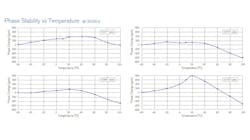RF/microwave engineers know this better than just about anyone (except for, perhaps, RF/microwave test engineers): Not all cable assemblies are created equal. An extremely critical facet of cable assemblies in the 5G era is their phase and amplitude stability over temperature variations (see figure) and with respect to flexure.
Check out more Technology Talks videos.
That's why Junkosha put so much energy into its MWX7 Series cable assemblies, which exploit the company's own dielectric ePTFE tape-wrapping technology to deliver both inter- and intra-batch performance consistency.
Both characterization and deployment of 5G large-scale, phased-array radar and MIMO systems count on the stability of RF interconnects like the MWX7 Series assemblies. Consider such radar installations and their criticality in detection of real-time defense threats.
These radar systems will often be deployed in locations that experience temperature extremes, both high and low. Therefore, the interconnects' stability in the face of such temperature shifts needs to be rock solid so that there's no lag in response times.
In this video, Junkosha's president and CEO, Joe Rowan, discusses the company's MWX7 Series cable assemblies, noting Junkosha's long-standing heritage in both mmWave technology and in creation/manipulation of ePTFE dielectric material. Both of these attributes are key to the development of the MWX7 Series cable assemblies.
Note also that Junkosha will be highlighting its MWX7 Series cables at the upcoming European Microwave Week, which is taking place this week in London at the ExCel London Exhibition and Conference Center.
Links:
About the Author
David Maliniak
Executive Editor, Microwaves & RF
I am Executive Editor of Microwaves & RF, an all-digital publication that broadly covers all aspects of wireless communications. More particularly, we're keeping a close eye on technologies in the consumer-oriented 5G, 6G, IoT, M2M, and V2X markets, in which much of the wireless market's growth will occur in this decade and beyond. I work with a great team of editors to provide engineers, developers, and technical managers with interesting and useful articles and videos on a regular basis. Check out our free newsletters to see the latest content.
You can send press releases for new products for possible coverage on the website. I am also interested in receiving contributed articles for publishing on our website. Use our contributor's packet, in which you'll find an article template and lots more useful information on how to properly prepare content for us, and send to me along with a signed release form.
About me:
In his long career in the B2B electronics-industry media, David Maliniak has held editorial roles as both generalist and specialist. As Components Editor and, later, as Editor in Chief of EE Product News, David gained breadth of experience in covering the industry at large. In serving as EDA/Test and Measurement Technology Editor at Electronic Design, he developed deep insight into those complex areas of technology. Most recently, David worked in technical marketing communications at Teledyne LeCroy, leaving to rejoin the EOEM B2B publishing world in January 2020. David earned a B.A. in journalism at New York University.

